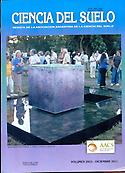View Item
- xmlui.general.dspace_homeCentros Regionales y EEAsCentro Regional La Pampa - San LuisEEA AnguilArtículos científicosxmlui.ArtifactBrowser.ItemViewer.trail
- DSpace Home
- Centros Regionales y EEAs
- Centro Regional La Pampa - San Luis
- EEA Anguil
- Artículos científicos
- View Item
Water use of wheat, corn and sunflower in the semiarid pampas = Uso del agua por trigo, maíz y girasol en la región semiárida pampeana
Abstract
Crop water use in semiarid environments allows designing management strategies to improve water use efficiency. Our objective was to estimate wheat (Triticum aestivum L.), maize (Zea mays L.) and sunflower (Helianthus annuus L.) water use in the Semiarid Pampas of Argentina and to identify the relative contribution from soil and from in-season rainfall. Data were collected from 138 field experiments conducted during 2000-2013 over an area of 15 Mha. Soil
[ver mas...]
Crop water use in semiarid environments allows designing management strategies to improve water use efficiency. Our objective was to estimate wheat (Triticum aestivum L.), maize (Zea mays L.) and sunflower (Helianthus annuus L.) water use in the Semiarid Pampas of Argentina and to identify the relative contribution from soil and from in-season rainfall. Data were collected from 138 field experiments conducted during 2000-2013 over an area of 15 Mha. Soil water content was measured 3-4 times during the crop growing season, in a total of 552 soil profile moisture determinations. Soil samples were taken every 20 cm in the entire rooting zone. Gravimetric water content was converted to stored water using measured bulk density. Rainfall during crop growing cycle was measured at each experimental site. Crop water use was calculated as the difference between soil water content at sowing minus the soil water content at harvest plus rainfall received during the growing season. Runoff and drainage were estimated and discounted from crop water use. Water use efficiency was estimated as the ratio between grain yield and crop water use. Water losses as runoff and drainage rounded 15% among the three crops. Average water use was 319 mm for wheat, 487 mm for maize, and 443 mm for sunflower while respective water use efficiencies were 7.3, 18.6 and 5.6 kg DM grain ha-1 mm-1 respectively. Approximately 90% of water used by crops corresponded apparently to the in-season rainfall whereas the contribution from stored soil water at sowing was relatively low, except in dry years when it represented around 25% of in-season crop water use.
[Cerrar]
La determinación de los requerimientos hídricos de los cultivos permite diseñar estrategias de manejo orientadas a un uso eficiente del agua. Nuestros objetivos fueron estimar el uso consuntivo de trigo (Triticum aestivum L.), maíz (Zea mays L.) y girasol (Helianthus annuus L.) en la Región Semiárida Pampeana y particionar el aporte del agua del suelo y la precipitación. Adicionalmente, calculamos la eficiencia de uso del agua para esos cultivos. Se
[ver mas...]
La determinación de los requerimientos hídricos de los cultivos permite diseñar estrategias de manejo orientadas a un uso eficiente del agua. Nuestros objetivos fueron estimar el uso consuntivo de trigo (Triticum aestivum L.), maíz (Zea mays L.) y girasol (Helianthus annuus L.) en la Región Semiárida Pampeana y particionar el aporte del agua del suelo y la precipitación. Adicionalmente, calculamos la eficiencia de uso del agua para esos cultivos. Se utilizó información generada en 138 ensayos realizados entre 2000 y 2013 distribuidos en un área de 15 Mha. Se realizaron 552 muestreos de humedad del suelo hasta una profundidad de 140 cm o hasta el límite superior de la capa petrocálcica en capas de 20 cm. La medición de agua gravimétrica se transformó a lámina usando la densidad aparente de cada capa de suelo. En cada sitio experimental se midieron las precipitaciones durante el ciclo de los cultivos. El uso consuntivo se calculó como la diferencia entre el nivel de agua del suelo a la siembra y a la cosecha más las precipitaciones. Las pérdidas de agua por escurrimiento y drenaje fueron estimadas y restadas al uso consuntivo. La eficiencia de uso del agua se calculó como la relación entre el rendimiento y el uso consuntivo. El uso consuntivo promedio fue de 319 mm en trigo, 487 mm en maíz y 443 mm en girasol y las eficiencias de uso del agua fueron de 7,3; 18,3 y 5,6 kg MS mm-1 respectivamente. Aproximadamente 90% del uso consuntivo fue aparentemente cubierto por las precipitaciones en los tres cultivos, siendo el aporte del agua del suelo en general pequeño excepto durante años secos en que alcanzó un 25% del uso consuntivo.
[Cerrar]

Author
Bono, Angel Alfredo;
Alvarez, Roberto;
De Paepe, Josefina Luisa;
Fuente
Ciencia del suelo 35 (2) : 273-283. (2017)
Date
2017
Editorial
Asociación Argentina de la Ciencia del Suelo
ISSN
1850-2067 (Online)
Formato
pdf
Tipo de documento
artículo
Palabras Claves
Derechos de acceso
Abierto
 Excepto donde se diga explicitamente, este item se publica bajo la siguiente descripción: Creative Commons Attribution-NonCommercial-ShareAlike 2.5 Unported (CC BY-NC-SA 2.5)
Excepto donde se diga explicitamente, este item se publica bajo la siguiente descripción: Creative Commons Attribution-NonCommercial-ShareAlike 2.5 Unported (CC BY-NC-SA 2.5)


